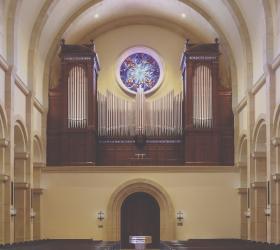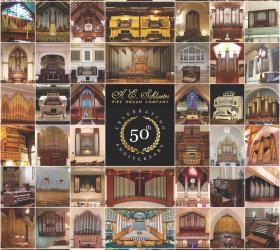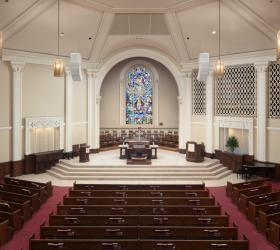
Cover
Andover Organ Company, Methuen, Massachusetts
St. Michael's Episcopal Church, Orlando, Florida, Opus 106
It seemed simple enough. Andrew Walker, music director at
St. Michael's Episcopal Church in Orlando, Florida, wrote to several pipe organ
builders including Andover Organ Company in May 1990, explaining that the
church had decided to replace its aging electronic. It had recently been
finished off by a bolt of lightning! By September 1991, after visits to many
organs, the committee selected Andover Organ Company. But before the happy
dedication of Opus 106 eight years later, the design had to grow through three
phases. Fortunately, the church
and the company maintained their faith in one another throughout the long
process, working together toward the best solution.
The church was built in 1958, with a shallow roofline and
tongue-in-groove wood ceiling. In the gallery, space was insufficient for the
organ that St. Michael's requested. Plans for the location at the rear of the
church necessitated redesigning the entrance, not a popular option with church
members.
By 1994, the church had decided to explore an organ with
choir seating at the center front of the sanctuary in conjunction with a
redesign of the altar area. The problem here was a glorious contemporary
stained glass window filling the top half of the front wall. There was also
some concern about moving a large cross hanging over the altar.
To solve these problems, Donald H. Olson and Jay H. Zoller
of Andover, in consultation with Andrew Walker, designed twin cases on either side
of the altar, with manual divisions on the left and the pedal division on the
right. The action would still be mechanical, linking manual and pedal divisions
with a tunnel under the altar to accommodate long trackers. This left the
window almost entirely visible. The contract was finally signed in June 1997.
The two matching cases feature facades of copper 16' Bourdon
pipes facing the congregation, and polished tin Great and Pedal Principal pipes
facing the center, in four symmetrical flats. Cases are red oak, stained to
match the woodwork in the church. Pipe shades are starbursts of contrasting
woods: maple, cherry, walnut and ash, with a revolving zimbelstern star at the
center of each. The console, including Solo, Great and Swell manuals, is detached
and reversed. When the Chamade is not being used, the solo manual acts as a
coupling manual.
Key action is mechanical with some electric action for
offset basses and Chamade. Couplers are operated electrically through an
additional set of pallets on the Great and Swell windchests. Combination action
is solid state from SSLL, with 8 levels of memory. Stop action is activated by
Harris drawknob units and Taylor stop action solenoids. The organ has 34 stops,
36 ranks, comprising a total of 1998 pipes.
Andover began construction in March 1997 and the instrument
was installed in June 1998, under the direction of Benjamin Mague, mechanical
director. Regulating and tuning was led by John Morlock, tonal director, over a
large part of the summer. A Chamade projecting under the stained glass window
was added in March 1999, with an insulated heat shield for protection from the
Florida sun, and with special lighting from beneath and behind.
Music director Andrew Walker worked with John Morlock and
Donald Olson to create a sound suited to Anglican liturgy in a room which is
rather dry acoustically. Walker particularly liked the full-bodied Andover Open
Diapasons, characterized by warmth and boldness without being overbearing, and
a chorus that was clear without harshness. Flutes are articulate but not
chiffy. The Swell Oboe was made according to Hook and Hastings scales. Three
trumpets in varying styles include the Hook-style Great Trumpet, the bright
French-style Swell Trompette, and the broad full sound of the Chamade with lots
of fundamental, which dominates but doesn't obliterate the full organ.
In November 1998, a week-long series of concerts celebrated
the new organ: a dedication and blessing November 8; a dedicatory recital by
Gerre Hancock, master of the choirs at St. Thomas Church, New York City,
November 12; and a choir festival led by Dr. Hancock November 14. Additional
concerts followed, by Murray Forbes Somerville in March 1999 and by Heinz
Wunderlich and violinist Nelly Söregi-Wunderlich in November 1999.
The Walker/Harris Organ was named in honor of Andrew Walker,
who has been music director at St. Michael's since 1980, and the family of
Stumpy and Dottie Harris, major donors for the organ.
Those who worked on the organ include Donald H. Olson,
president, church liaison, case design; John W. Morlock, tonal director; Jay
Harold Zoller, mechanical design, case design, installation; Benjamin G. Mague,
mechanical director, installation; Ed-ward C. Bradley, windchests, case
finishing and installation; Betty Swett, secretary; Anne J. Doré, office
manager; Michael W. Eaton, windchests, action and installation; Kirk Garner,
case finishing; Albert Hosman, Jr., casework; Paul McNamara, wiring and tonal
finishing; Felicia F. Morlock, pipe racking and pre-voicing; Donald E. Reich,
wood pipemaker; Eleanor Richardson, pipe racking, rollerboards, pipe shades;
Craig A. Seaman, wiring, installation, tonal finishing; James Stewart, wind
system; Thomas E. Turmel, pipe racking, offset tubing; Paul Byron, pipemaker;
Jósef Lasota & Sons, pipemaker; Süddeutsch Orgelpfeifen Fabrik,
reed pipes.
Photo credit: Starling Productions
Notes from music director Andrew Walker
I began my ministry at St. Michael's in the summer of 1980.
At that point there was a nine-year-old electronic organ situated in the
balcony at the rear of the church. The speakers were hidden behind a facade of
organ pipes arranged to look like a pipe organ case. This organ had been
damaged in a lightning strike to the church, the capture action was mechanical,
noisy, and obsolete, finding a technician to work on the instrument was a
problem; in other words, a replacement was going to be needed at some point in
the future.
From 1980-1990 the choir grew to a size where it overfilled
the space available in the balcony. Beginning in 1989 a search was begun to
find a replacement for the organ, and address the issue of extra choir space.
After two years of extensive investigation including visits to organs in the
United States and in the United Kingdom, the organ committee chose Andover
Organ Company to build a new instrument.
The initial idea for organ placement involved extending the
west wall of the church out 20 feet, removing the balcony, and constructing a
platform on which the organ and the choir would be placed. The instrument would
be in one case, speaking down the central aisle of the church. However, a
central aisle entrance into the church would be lost. When this idea was
presented to the congregation it met with disapproval.
Plan B involved reorganizing the altar area of the church in
which there was a large amount of wasted space. Andover's first design put the
organ in two cases, one on either side of the altar, choir space behind the
altar, the two cases straddling one of the large A frames holding up the roof.
It was quickly discovered that this would necessitate removing four
congregational pews. This was also unacceptable.
Plan C involved an ingenious mech-anical solution on the
part of Andover permitting each case to straddle two of the A frames. This
resulted in a loss of only two congregational pews, and the solution was found.
The acoustical properties of the building are somewhat on
the dead side when the church is half filled or more. I did not want an
instrument that would scream at those listening or singing. This resulted in
the choice of an instrument that is Diapason-based with strong foundations. The
sound is warm, envel-oping, exciting and "brassy" when needed, and
full organ fills the room without being overbearing.
From the very beginning, the primary responsibility of the
organ has always been defined as the accompanying of congregational singing,
then accompanying a choir, and finally the playing of organ literature. We use
a broad range of congregational material at St. Michael's, the choir sings literature
from plainsong through 20th-century classical and contemporary sacred
literature, I like to play, and visiting organists have played, a broad range
of organ literature. The instrument performs admirably in all these roles, and
has been enthusiastically received by the congregation and visiting musicians.
There is enough space for the choir members, adults and youth together,
numbering up to 60. One of the most interesting comments we received from many
members of the congregation after the installation was ". . . it looks
more like a church now!"
Andrew Walker
GREAT
16' style='mso-tab-count:1'> Bourdon
8'
style='mso-tab-count:1'> Open
Diapason
8'
style='mso-tab-count:1'> Stopped
Diapason
4' style='mso-tab-count:1'> Octave
4'
style='mso-tab-count:1'> Chimney
Flute
22/3' style='mso-tab-count:1'> Twelfth
22/3' style='mso-tab-count:1'> Nazard
2' style='mso-tab-count:1'> Fifteenth
2' style='mso-tab-count:1'> Recorder
13/5' style='mso-tab-count:1'> Tierce
IV-V style='mso-tab-count:1'> Mixture
8' style='mso-tab-count:1'> Trumpet
Zimbelstern
SWELL
8'
style='mso-tab-count:1'> Violin
Diapason
8'
style='mso-tab-count:1'> Celeste
(49 pipes)
8' style='mso-tab-count:1'> Bourdon
4' style='mso-tab-count:1'> Principal
4' style='mso-tab-count:1'> Flute
2' style='mso-tab-count:1'> Octavin
11/3' style='mso-tab-count:1'> Quint
III style='mso-tab-count:1'> Mixture
16' style='mso-tab-count:1'> Fagott
8' style='mso-tab-count:1'> Trompette
8' style='mso-tab-count:1'> Hautboy
Tremolo
SOLO
16'
style='mso-tab-count:1'> Trompette
en Chamade (TC)
8'
style='mso-tab-count:1'> Trompette
en Chamade
PEDAL
16'
style='mso-tab-count:1'> Double
Open Diapason
16' style='mso-tab-count:1'> Subbass
16'
style='mso-tab-count:1'> Bourdon
(32 notes)
102/3' style='mso-tab-count:1'> Contra Quint (prep)
8' style='mso-tab-count:1'> Principal
8'
style='mso-tab-count:1'> Flutebass
(32 notes)
4' style='mso-tab-count:1'> Choralbass
16' style='mso-tab-count:1'> Trombone
8' style='mso-tab-count:1'> Trumpet
Couplers
Swell
to Great
Swell
to Solo
Great
to Solo
Great
to Pedal
Swell
to Pedal
Solo
to Pedal




